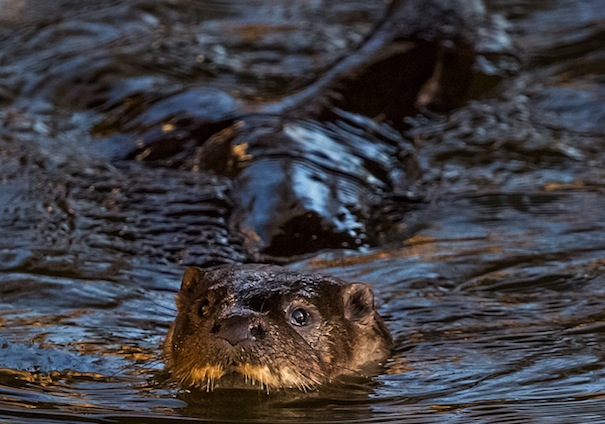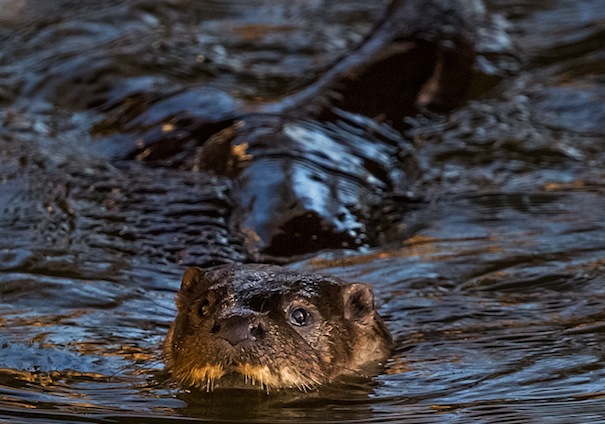
Edward Andrews gets up close and personal with the stars of the local show – the Bridgnorth otters.
It’s 6am on a Monday in March and Bridgnorth is sleeping under a blanket of cloud as I walk across the damp grass towards the river. I pass the neatly-trimmed beech hedge of the Bylet Bowling Club and am suddenly greeted by a cacophony of sound as the geese awaken.
As I stand on the bridge scanning the river with my binoculars, the street lights are reflected like orange beacons, and the daily commute is underway behind me. I wonder if the drivers are aware that for the last few weeks, local people have been getting incredible views of one of the UK’s most charismatic animals: the talk of the town has been ‘our otters’, and social media has been bursting with photos and videos.
A long-term quest
I should explain my history with otters. I’ve spent considerable effort trying to observe them in the wild, without success. I’d sit for hours by lonely Scottish lochs, watching for movement amongst the rocks – nothing. Today I find myself standing on a bridge in the middle of my home town with a road sweeper driving past me… it seems a long way from the tranquillity of a Scottish loch.
Others have collected on the bank, and a dog-walker tells me he normally sees the otters by the rowing club. I wander up the path, watching the silhouette of a kingfisher in the early morning gloom; he dives and snatches a fish before disappearing from view – but no otters.
I make my way back and suddenly, out of the corner of my eye, I spot a shadow under the arch of the bridge. I grab the binoculars and, to my joy, I am watching an otter. Despite the twisting current, he moves effortlessly through the water and I can see the sheen to his fur when his head emerges again after a dive.
Putting on a show
The otter disappears, but I spot a group of people on the quayside. I arrive just in time to see a large dog otter putting on quite a show; children in school uniforms are taking pictures on a camera phone. The dog otter investigates the entrance to an old concrete pipe, and I’m amazed by the speed with which he moves through the water and the wonderful flowing lines he creates. Otters tend to be shy and mainly active at night… clearly the Bridgnorth otters have not read the handbook.
In the 1960s, otters pretty much disappeared from English lowland rivers. Pesticides (particularly DDT) were washing from farmland into rivers and industrial chemicals were also entering the water. These were absorbed by fish, and otters were being poisoned after eating large quantities of fish. Today water quality is much more tightly regulated, and this is helping otters to thrive again.
Sharing the magic
Encounters with wildlife bring people from all backgrounds together with a sense of wonder and awe. In the shared surroundings of the riverbank, the magic of the otters has been enchanting everyone who witnesses them. Dog otters can have a large territory, so there is always the possibility that ‘our otters’ may soon disappear beneath the surface of the water and leave Bridgnorth; this makes the encounters all the more special.
Do one thing for wildlife this month…
Otters are a top predator in the river ecosystem. For otters to continue to thrive, high water quality must be maintained and improved. The Canal and River Trust are always looking for people to volunteer to help keep our waterways healthy. Work can include adopting a stretch of river or canal, helping wildlife and leading educational visits. Why not give a few hours and become an ambassador for the conservation of our river wildlife? For more information, please see: www.canalrivertrust.org.uk/volunteering
What’s What! nature expert Edward Andrews (MSc) works for the National Trust as Ranger for the Shropshire Hills. He shares the best of the local seasons with us each issue
Pictures kindly donated by Andrew Fusek Peters – www.andrewfusekpeters.com






